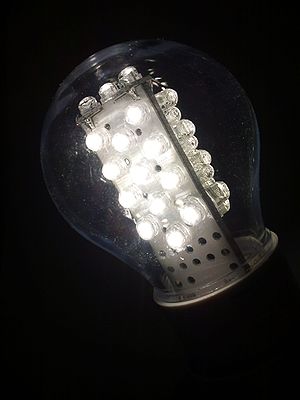
- Image via Wikipedia
We bought our first LED light bulb a few months ago and put it into our desk lamp. The suspicious yet understandable issue with LED lightbulbs is lumens.
We aren’t used to lumens. We’re used to watts. Even though they aren’t accurate. CFL lightbulbs are labeled with lumens, which indicate light output, but they also note the equivalent in a traditional incandescent bulb because that is what we understand. Those notes are suspiciously missing from the LED packaging we see.
Even CNET’s Green Tech, and its editor, Martin LaMonica agrees with us. But, he advises that is changing. He tried some samples from Lighting Science Group, which manufactures many of the LED bulbs for Home Depot‘s Ecosmart line. The bulbs are available on the Home Depot website, and should be in stores sometime this month.
But these bulbs which are getting brighter and more capable of what we demand of them are not cheap. Twenty to thirty-five dollars for a single light bulb is a bit much. The savings over time are a consideration, but the price will have to drop before it becomes a mainstream option.
The Department of Energy is set to unveil a program to help shoppers understand these new options. They will have a new label called Lighting Facts. It certainly will help if all bulbs use the same designations. We guess it is time to internalize the lumens system.
In the meantime, we have added some Sylvania ACCENT LED bulbs to a bathroom. Three produce enough to shine in this small room. But we knew that going in that they weren’t incredibly bright. We compared the lumens to the package of CFLs next to them at the store.
The concern is that the information isn’t getting to us. The New York Times reports that the Federal Trade Commission is suing Lights of America for misrepresenting the light output and life expectancy of their LED lightbulbs. For example, the company claimed one of its bulbs could replace a 40-watt incandescent, which typically puts out 400 lumens. They found the bulb in question only produced 74 lumens. In addition, they claimed another bulb would last 30,000 hours, but lost 80% of its light output after only 1,000 hours.
The company responded by stating that the bulbs that are the focus of the suit were introduced before formal standards were established for LED’s. Furthermore, they advise that they already responded by removing the equivalency claims from its packaging…which explains why the useful comparison of equivalency is omitted from LED packaging.
In the end, we’ll continue to experiment with these bulbs. Why? Because they last longer, use less electricity, and like the CFLs of a few years ago, will continue to improve. Why? Because the government and the public demands it.
Related articles by Zemanta
- LED bulbs in the home: So far, so good (news.cnet.com)
- LED bulbs creep into the home (photos) (news.cnet.com)
- Home Depot’s $20 LED: Lights out for older bulbs? (blogs.consumerreports.org)
- Home Depot Teams Up With Philips, Cree on LED Bulbs (fool.com)
- Federal Agency Sues LED Bulb Maker (green.blogs.nytimes.com)
- Energy-saving LED light bulbs: false claims? (latimesblogs.latimes.com)




